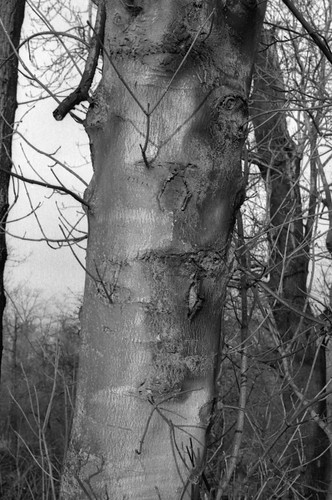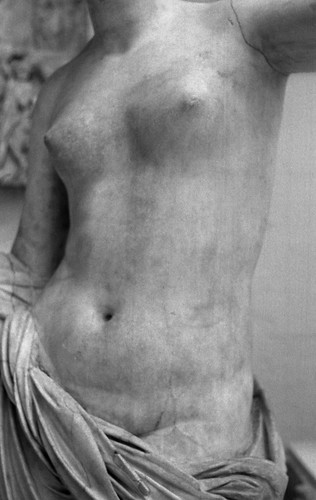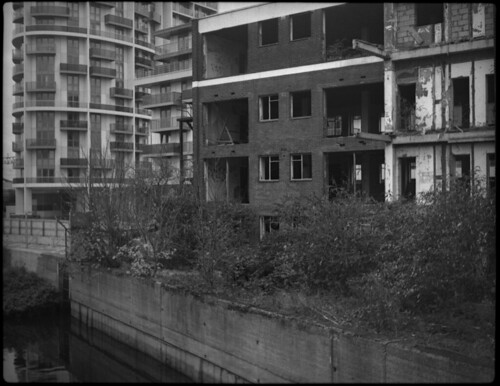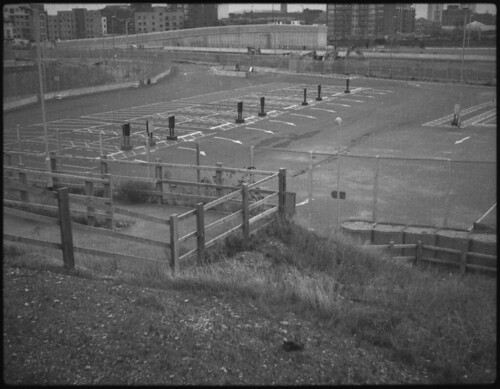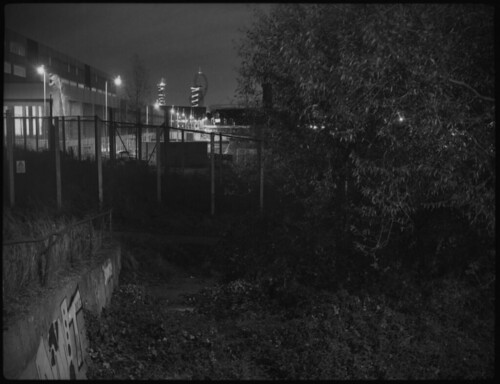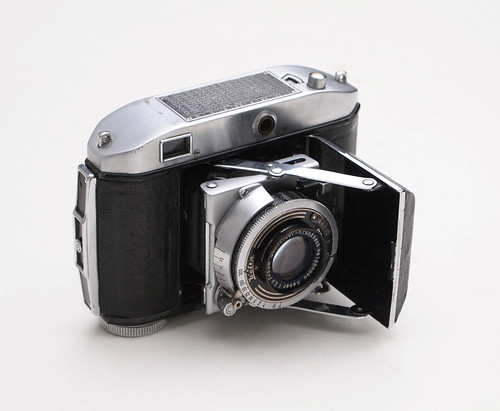 |
| Weltini II with f2.8 50mm Schneider Kreuznach Xenar lens in Compur shutter |
When Kodak introduced the daylight-loading
35mm cartridge in 1934 it helped to popularise the use of 35mm film for still photography. Many camera manufacturers soon produced cameras inspired by Kodak's
Retina, the first camera designed for the 35mm cartridge. As the Retina was designed and built in Germany by the
Nagel cameraworks in Stuttgart (acquired by Kodak in 1931), it is perhaps unsurprising that many of the early 35mm cameras inspired by the Retina were produced by Nagel's German competitors such as
Certo,
Balda and
Welta.
Welta's 35mm cameras closely follow the development of the Retina. The first Retina model was scale-focused but was soon followed in 1936 by the Retina II, a rangefinder version. A year behind Kodak AG, Welta brought out the scale-focused 35mm
Welti in 1935, and a rangefinder version, called the Weltini, in 1937. My Weltini is the second version, which although not given a different name by the manufacturers, is generally referred to as the
Weltini II to distinguish the camera from the original model. The Weltini cameras were closely based on the Welti, and used the some of the same components, notably the body itself, a design decision undertaken for the economics of production. As a result of fitting the rangefinder to the Welti body, the camera is in essence turned upside down, meaning the Weltini opens from the opposite side, the advance and rewind knobs are on the camera's bottom plate, the shutter release is on the left, and the film runs left to right inside the camera (which means that the negatives read right to left in sequence, in reverse to most 35mm cameras). The left-handedness of the Weltini also seems to extend to the
frame counter reset and rewind release, small levers on the back of the camera most easily operated with the thumb of the left hand. The Weltini II greatly redesigned the first version's 'bolted on' look, streamlining the whole top plate (providing space for
a depth of field scale), reducing the bottom plate's profile. Some minor changes to the Weltini II also occurred during production: the body release was redesigned, the stand for vertical images was changed to fold in the other direction and the shutter release was given a sharper rim. The picture below shows the Weltini next to a Weltix, a cheaper version of the Welti.
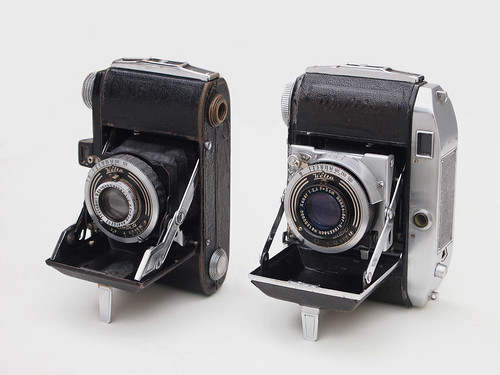 |
| Welta Weltix (left) and Weltini |
My Weltini came with a non-working shutter, a Compur-Rapid which had the cable release socket missing, so presumably had been used to donate components to repair another shutter. I subsequently
bought the Weltix camera which had a working Compur shutter with a
Steinheil Cassar f2.9 lens. The Weltini had a Schneider Kreuznach Xenar f2.8 lens with a rather neat serial number: 120000 (dating it to December 1937). My intention was to simply swap the shutters, but I soon discovered that although similar, the linkages to the shutter release are different, which meant that simply replacing the non-working Compur-Rapid with the Compur shutter would mean having to use the Weltini with a cable release, or just tripping the release lever where the linkage is attached to the shutter - not uncommon to cameras from the first half of the 20th century - but the bottom folding strut is positioned just in the right place to make this difficult.
As a result of having to open the shutters and forcibly remove the linkage and release mechanism from the rest of the components (best left to those with more experience), in my clumsy attempt to put the shutters back together I didn't do a very good job on the Compur - although not tested for accuracy, the only speeds that sound near to being accurate are at 1/100th and 1/300th, which, although the Weltini camera is now working, does limit its use.
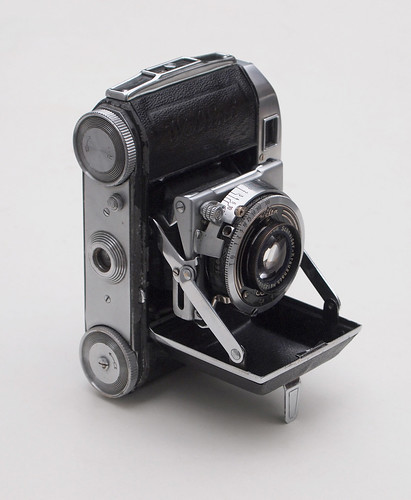 |
Weltini II, showing advance and rewind knobs.
The advance release button is just discernible against the gunmetal where the paint is worn away. |
Having shot some film in the camera, with all the constraints of the shutter speeds taken into consideration, the Weltini is undeniably awkward in use. The nearest comparison I can make is to my
Kodak Retina IIa, although it's not a fair one as the Retina IIa is a later camera, evolved from the original and contemporary Retina II rangefinder. However, thanks to the Weltini's construction, operation of the camera isn't all that smooth, mainly due to the advance knob being on the underside of the camera. There is small flat button under the lens which releases the film advance for each frame (this interlock requires the sprockets inside to be turned, either with film or manually), and when in the Weltini's ever-ready case, which has parts cut out specifically to use these controls, they are quite small and not instinctively easy to access. To add to this, the advance lever feels like it should naturally turn in the other direction than it does. One advance over the Retina is that the Weltini has a lever which resets the focus of the lens to infinity automatically while closing, and closed, the elegant design of the Weltini II's rangefinder housing and low profile advance and rewind knobs do make for a fairly smooth, if heavy, pocketable camera. For its aesthetics, I wanted to like the Weltini more than I did. Perhaps a left-handed photographer would find the Weltini II a more instinctive fit.
 |
| Sample image from Weltini II on Ilford FP4 |
 |
| Sample image from Weltini II on Ilford Ilfodata HS23 |
 |
| Sample image from Weltini II on Ilford Mark V Motion Picture film |
Sources/further reading:
http://camera-wiki.org/wiki/Weltini
http://galactinus.net/vilva/retro/weltini2.html
http://rick_oleson.tripod.com/index-174.html



